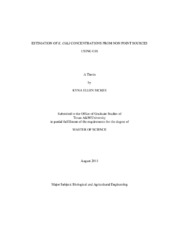| dc.description.abstract | When developing a Watershed Protection Plan (WPP) or a Total Maximum Daily Load (TMDL), it is often difficult to accurately assess the pollutant load for a watershed because not enough water quality monitoring data are available. According to the Texas Commission on Environmental Quality (TCEQ), there are 274 bacteria impairments in Texas water bodies out of 386 impaired water bodies. Bacteria water quality data are often more sparse than other types of water quality data, which hinders the development of WPPs or TMDLs. The Spatially Explicit Load Enrichment Calculation Tool (SELECT) was used to develop watershed protection plans for four rural watersheds in Texas that are impaired due to E. coli bacteria. SELECT is an automated Geographical Information System (GIS) tool that can assess pathogen loads in watersheds using spatial factors such as land use, population density, and soil type. WPPs were developed for four rural Texas watersheds: Buck Creek, Lampasas River, five sub watersheds of the Little Brazos River, and Geronimo Creek. A spatial watershed model was developed to simulate bacteria concentrations in streams resulting from non point sources using SELECT combined with a simple rainfall-runoff model and applied to the Geronimo Creek watershed. The watershed model applies a rainfall-driven loading function to the potential E. coli loads calculated by the output of SELECT. The simulated runoff volumes and E. coli concentrations from the model were compared to actual monthly E. coli data collected at two sampling sites near the outlet of a subwatershed.
The results show how SELECT methodology was applied to each watershed and adapted based on stakeholder concerns and data availability. The highest potential contributors were identified and areas of concern were highlighted to more effectively apply best management practices (BMPs). The runoff volumes were predicted with very good agreement (E = 0.95, RSR = 0.21 to 0.22) for both sampling sites. The predicted E. coli concentrations did not agree with measured concentrations for both sites using eight different methods. The results indicate that the model does not include significant factors contributing to the transport of E. coli bacteria but can be modified to include these factors. | en |


